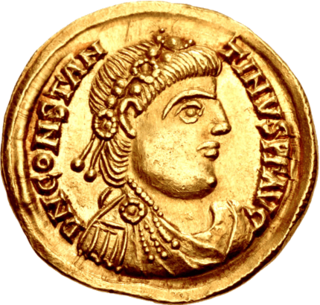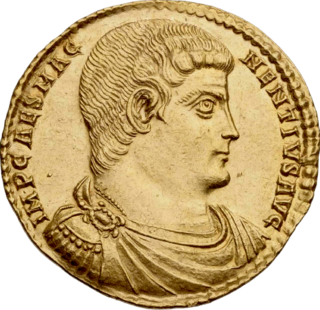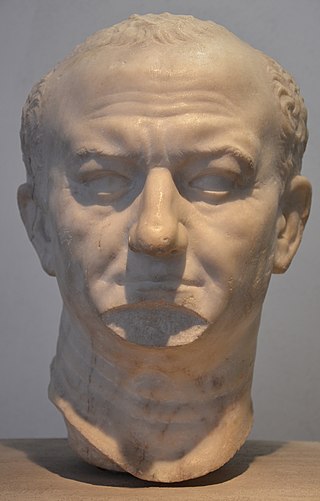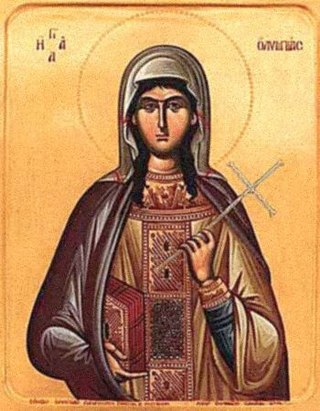Related Research Articles

Flavius Julius Constans, also called Constans I, was Roman emperor from 337 to 350. He held the imperial rank of caesar from 333, and was the youngest son of Constantine the Great.

Constantine II was Roman emperor from 337 to 340. Son of Constantine the Great and co-emperor alongside his brothers, his attempt to exert his perceived rights of primogeniture led to his death in a failed invasion of Italy in 340.

Constantine III was a common Roman soldier who was declared emperor in Roman Britain in 407 and established himself in Gaul. He was recognised as co-emperor of the Roman Empire from 409 until 411.

Lucius Aelius Sejanus, commonly known as Sejanus, was a Roman soldier, friend, and confidant of the Roman Emperor Tiberius. Of the Equites class by birth, Sejanus rose to power as prefect of the Praetorian Guard, the imperial bodyguard, of which he was commander from AD 14 until his execution for treason in AD 31.

The Praetorian Guard was an elite unit of the Imperial Roman army that served as personal bodyguards and intelligence agents for the Roman emperors.

Magnus Magnentius was a Roman general and usurper against Constantius II. Of Germanic descent, Magnentius served with distinction in Gaul under the emperor Constans. On 18 January 350 Magnentius was acclaimed Augustus. Quickly killing the unpopular Constans, Magnentius gained control over most of the Western Empire. The Eastern emperor Constantius II, the brother of Constans, refused to acknowledge Magnentius' legitimacy and led a successful campaign against Magnentius. Ultimately, Magnentius' forces were scattered after the Battle of Mons Seleucus, and he died by suicide on 10 August 353.

Petronius Maximus was Roman emperor of the West for two and a half months in 455. A wealthy senator and a prominent aristocrat, he was instrumental in the murders of the Western Roman magister militum, Aëtius, and the Western Roman emperor, Valentinian III.

The term Western Roman Empire is used in modern historiography to refer to the western provinces of the Roman Empire, collectively, during any period in which they were administered separately from the eastern provinces by a separate, independent imperial court. Particularly during the period from AD 395 to 476, there were separate, coequal courts dividing the governance of the empire into the Western provinces and the Eastern provinces with a distinct imperial succession in the separate courts. The terms Western Roman Empire and Eastern Roman Empire were coined in modern times to describe political entities that were de facto independent; contemporary Romans did not consider the Empire to have been split into two empires but viewed it as a single polity governed by two imperial courts for administrative expediency. The Western Empire collapsed in 476, and the Western imperial court in Ravenna disappeared by AD 554, at the end of Justinian's Gothic War.
The praetorian prefect was a high office in the Roman Empire. Originating as the commander of the Praetorian Guard, the office gradually acquired extensive legal and administrative functions, with its holders becoming the Emperor's chief aides. Under Constantine I, the office was much reduced in power and transformed into a purely civilian administrative post, while under his successors, territorially-defined praetorian prefectures emerged as the highest-level administrative division of the Empire. The prefects again functioned as the chief ministers of the state, with many laws addressed to them by name. In this role, praetorian prefects continued to be appointed by the Eastern Roman Empire until the reign of Heraclius in the 7th century AD, when wide-ranging reforms reduced their power and converted them to mere overseers of provincial administration. The last traces of the prefecture disappeared in the Byzantine Empire by the 840s.

Constans II was the son of Western Roman emperor Constantine III, and served as his co-emperor from 409 to 411. Constans was a monk prior to his father being acclaimed emperor by the army in Britain in early 407, an act of rebellion against the ruling emperor Honorius. He was summoned to Gaul, appointed to the position of caesar (heir) and swiftly married so that a dynasty could be founded. In Hispania, Honorius's relatives rose in 408 and expelled Constantine's administration. An army under the generals Constans and Gerontius was sent to deal with this and Constantine's authority was re-established. Honorius acknowledged Constantine as co-emperor in early 409 and Constantine immediately raised Constans to the position of augustus (emperor), theoretically equal in rank to Honorius as well as to Constantine. Later in 409 Gerontius rebelled, proclaimed his client Maximus emperor and incited barbarian groups in Gaul to rise up. Constans was sent to quash the revolt, but was defeated and withdrew to Arles. In 410, Constans was sent to Hispania again. Gerontius had strengthened his army with barbarians and defeated Constans; the latter withdrew north and was defeated again and killed at Vienne early in 411. Gerontius then besieged Constantine in Arles and killed him.

The gens Flavia was a plebeian family at ancient Rome. Its members are first mentioned during the last three centuries of the Republic. The first of the Flavii to achieve prominence was Marcus Flavius, tribune of the plebs in 327 and 323 BC; however, no Flavius attained the consulship until Gaius Flavius Fimbria in 104 BC. The gens became illustrious during the first century AD, when the family of the Flavii Sabini claimed the imperial dignity.
The Battle of Mursa was fought on 28 September 351 between the eastern Roman armies led by the Emperor Constantius II and the western forces supporting the usurper Magnentius. It took place at Mursa, near the Via Militaris in the province of Pannonia. The battle, one of the bloodiest in Roman history, was a pyrrhic victory for Constantius.

The praefectus urbanus, also called praefectus urbi or urban prefect in English, was prefect of the city of Rome, and later also of Constantinople. The office originated under the Roman kings, continued during the Republic and Empire, and held high importance in late Antiquity. The office survived the collapse of the Western Roman Empire, and the last urban prefect of Rome, named Iohannes, is attested in 599. In the East, in Constantinople, the office survived until the 13th century.
In historiography, the Later Roman Empire traditionally spans the period from 284 to 641 in the history of the Roman Empire.

Olympias, also known as Saint Olympias and sometimes known as Olympias the Younger to distinguish her from her aunt of the same name was a Christian Roman noblewoman of Greek descent.
Aconius CatullinussignoPhilomatius was a Roman senator who held high state offices under the emperor Constans.
Ulpius Limenius was a Roman politician who was appointed consul in AD 349.
Flavius Romulus was a Roman politician, appointed to the high position of consul in 343. The historian Benet Salway tentatively identified him with Romulus, the senior army officer who fought and died for the usurper Magnentius at the Battle of Mursa in 351.
Fabius Titianus was a Roman politician and senator in the fourth century AD.